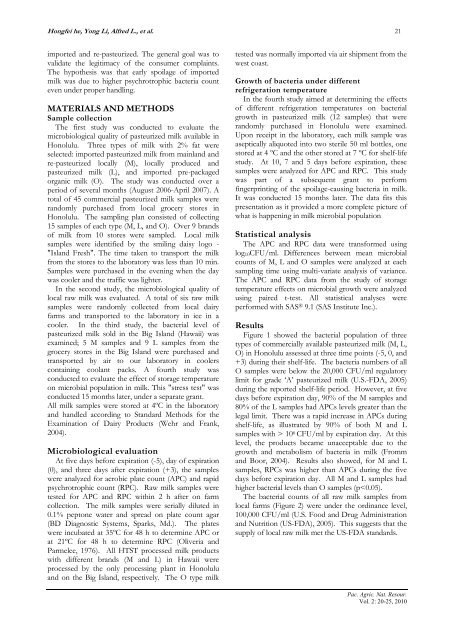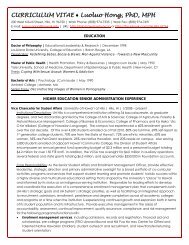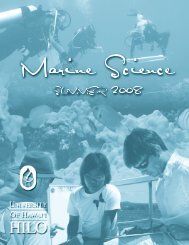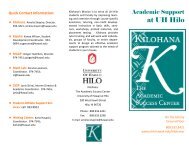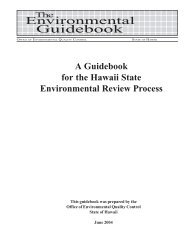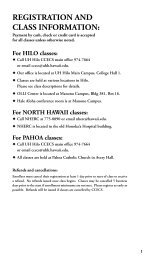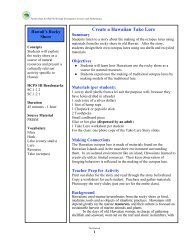Microbiological Quality of Pasteurized Milk in Hawai`i - University of ...
Microbiological Quality of Pasteurized Milk in Hawai`i - University of ...
Microbiological Quality of Pasteurized Milk in Hawai`i - University of ...
Create successful ePaper yourself
Turn your PDF publications into a flip-book with our unique Google optimized e-Paper software.
Hongfei he, Yong Li, Alfred L., et al. 21<br />
imported and re-pasteurized. The general goal was to<br />
validate the legitimacy <strong>of</strong> the consumer compla<strong>in</strong>ts.<br />
The hypothesis was that early spoilage <strong>of</strong> imported<br />
milk was due to higher psychrotrophic bacteria count<br />
even under proper handl<strong>in</strong>g.<br />
MATERIALS AND METHODS<br />
Sample collection<br />
The first study was conducted to evaluate the<br />
microbiological quality <strong>of</strong> pasteurized milk available <strong>in</strong><br />
Honolulu. Three types <strong>of</strong> milk with 2% fat were<br />
selected: imported pasteurized milk from ma<strong>in</strong>land and<br />
re-pasteurized locally (M), locally produced and<br />
pasteurized milk (L), and imported pre-packaged<br />
organic milk (O). The study was conducted over a<br />
period <strong>of</strong> several months (August 2006-April 2007). A<br />
total <strong>of</strong> 45 commercial pasteurized milk samples were<br />
randomly purchased from local grocery stores <strong>in</strong><br />
Honolulu. The sampl<strong>in</strong>g plan consisted <strong>of</strong> collect<strong>in</strong>g<br />
15 samples <strong>of</strong> each type (M, L, and O). Over 9 brands<br />
<strong>of</strong> milk from 10 stores were sampled. Local milk<br />
samples were identified by the smil<strong>in</strong>g daisy logo -<br />
"Island Fresh". The time taken to transport the milk<br />
from the stores to the laboratory was less than 10 m<strong>in</strong>.<br />
Samples were purchased <strong>in</strong> the even<strong>in</strong>g when the day<br />
was cooler and the traffic was lighter.<br />
In the second study, the microbiological quality <strong>of</strong><br />
local raw milk was evaluated. A total <strong>of</strong> six raw milk<br />
samples were randomly collected from local dairy<br />
farms and transported to the laboratory <strong>in</strong> ice <strong>in</strong> a<br />
cooler. In the third study, the bacterial level <strong>of</strong><br />
pasteurized milk sold <strong>in</strong> the Big Island (Hawaii) was<br />
exam<strong>in</strong>ed; 5 M samples and 9 L samples from the<br />
grocery stores <strong>in</strong> the Big Island were purchased and<br />
transported by air to our laboratory <strong>in</strong> coolers<br />
conta<strong>in</strong><strong>in</strong>g coolant packs. A fourth study was<br />
conducted to evaluate the effect <strong>of</strong> storage temperature<br />
on microbial population <strong>in</strong> milk. This "stress test" was<br />
conducted 15 months later, under a separate grant.<br />
All milk samples were stored at 4ºC <strong>in</strong> the laboratory<br />
and handled accord<strong>in</strong>g to Standard Methods for the<br />
Exam<strong>in</strong>ation <strong>of</strong> Dairy Products (Wehr and Frank,<br />
2004).<br />
<strong>Microbiological</strong> evaluation<br />
At five days before expiration (-5), day <strong>of</strong> expiration<br />
(0), and three days after expiration (+3), the samples<br />
were analyzed for aerobic plate count (APC) and rapid<br />
psychrotrophic count (RPC). Raw milk samples were<br />
tested for APC and RPC with<strong>in</strong> 2 h after on farm<br />
collection. The milk samples were serially diluted <strong>in</strong><br />
0.1% peptone water and spread on plate count agar<br />
(BD Diagnostic Systems, Sparks, Md.). The plates<br />
were <strong>in</strong>cubated at 35ºC for 48 h to determ<strong>in</strong>e APC or<br />
at 21ºC for 48 h to determ<strong>in</strong>e RPC (Oliveria and<br />
Parmelee, 1976). All HTST processed milk products<br />
with different brands (M and L) <strong>in</strong> Hawaii were<br />
processed by the only process<strong>in</strong>g plant <strong>in</strong> Honolulu<br />
and on the Big Island, respectively. The O type milk<br />
tested was normally imported via air shipment from the<br />
west coast.<br />
Growth <strong>of</strong> bacteria under different<br />
refrigeration temperature<br />
In the fourth study aimed at determ<strong>in</strong><strong>in</strong>g the effects<br />
<strong>of</strong> different refrigeration temperatures on bacterial<br />
growth <strong>in</strong> pasteurized milk (12 samples) that were<br />
randomly purchased <strong>in</strong> Honolulu were exam<strong>in</strong>ed.<br />
Upon receipt <strong>in</strong> the laboratory, each milk sample was<br />
aseptically aliquoted <strong>in</strong>to two sterile 50 ml bottles, one<br />
stored at 4 ºC and the other stored at 7 ºC for shelf-life<br />
study. At 10, 7 and 5 days before expiration, these<br />
samples were analyzed for APC and RPC. This study<br />
was part <strong>of</strong> a subsequent grant to perform<br />
f<strong>in</strong>gerpr<strong>in</strong>t<strong>in</strong>g <strong>of</strong> the spoilage-caus<strong>in</strong>g bacteria <strong>in</strong> milk.<br />
It was conducted 15 months later. The data fits this<br />
presentation as it provided a more complete picture <strong>of</strong><br />
what is happen<strong>in</strong>g <strong>in</strong> milk microbial population<br />
Statistical analysis<br />
The APC and RPC data were transformed us<strong>in</strong>g<br />
log 10CFU/ml. Differences between mean microbial<br />
counts <strong>of</strong> M, L and O samples were analyzed at each<br />
sampl<strong>in</strong>g time us<strong>in</strong>g multi-variate analysis <strong>of</strong> variance.<br />
The APC and RPC data from the study <strong>of</strong> storage<br />
temperature effects on microbial growth were analyzed<br />
us<strong>in</strong>g paired t-test. All statistical analyses were<br />
performed with SAS ® 9.1 (SAS Institute Inc.).<br />
Results<br />
Figure 1 showed the bacterial population <strong>of</strong> three<br />
types <strong>of</strong> commercially available pasteurized milk (M, L,<br />
O) <strong>in</strong> Honolulu assessed at three time po<strong>in</strong>ts (-5, 0, and<br />
+3) dur<strong>in</strong>g their shelf-life. The bacteria numbers <strong>of</strong> all<br />
O samples were below the 20,000 CFU/ml regulatory<br />
limit for grade ‘A’ pasteurized milk (U.S.-FDA, 2005)<br />
dur<strong>in</strong>g the reported shelf-life period. However, at five<br />
days before expiration day, 90% <strong>of</strong> the M samples and<br />
80% <strong>of</strong> the L samples had APCs levels greater than the<br />
legal limit. There was a rapid <strong>in</strong>crease <strong>in</strong> APCs dur<strong>in</strong>g<br />
shelf-life, as illustrated by 90% <strong>of</strong> both M and L<br />
samples with > 10 6 CFU/ml by expiration day. At this<br />
level, the products became unacceptable due to the<br />
growth and metabolism <strong>of</strong> bacteria <strong>in</strong> milk (Fromm<br />
and Boor, 2004). Results also showed, for M and L<br />
samples, RPCs was higher than APCs dur<strong>in</strong>g the five<br />
days before expiration day. All M and L samples had<br />
higher bacterial levels than O samples (p


